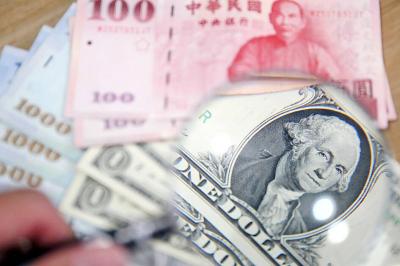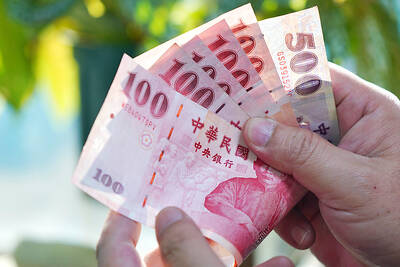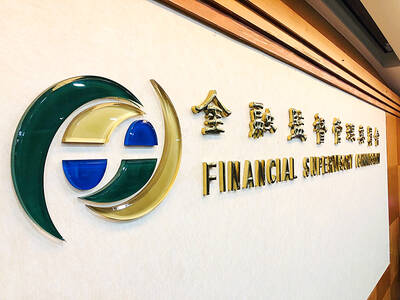As France faces a 2035 deadline to phase out new combustion engine vehicles, workers in the industry worry their days might be numbered too.
While there is plenty of optimism in certain regions of France, in particular in the north of the country where a “Battery Valley” is emerging, workers at parts suppliers elsewhere are pessimistic.
With the sale of new vehicles with gasoline and diesel engines allowed for only the next decade in Europe, the industry that employs 200,000 people in France faces a forced march to change.

Photo: AFP
“The transition [to electric vehicles], it could have been done when Walor bought us but they didn’t invest,” said Severine Person, a quality control expert at the company’s facility in the town of Vouziers in France’s northeastern Ardennes region.
Walor SA bought the facility in 2018. Its production of connecting rods for tractors and trucks is not threatened by the shift to electric vehicles (EVs), but demand for transmission differential housings and engine manifolds is likely to see big changes.
Walor was bought out last year by a German fund that specializes in turning around struggling firms and is looking to sell the site in Vouziers and another nearby.
“Before, Citroen would distribute work to everyone in the Ardennes. They didn’t go to the other side of the world to get parts,” said Bruno Bodson, a shop steward with the French Democratic Confederation of Labor trade union.
Person and her colleagues are resigned to the factory’s likely closure given its shrinking order book.
However, the mood is different in the north, where a number of battery “gigafactories” are being built, including that of the Automotive Cells Co (ACC) in Douvrin.
The joint venture includes automakers Stellantis NV and Mercedes AG along with French oil and gas giant TotalEnergies SE.
ACC built its massive battery plant on the site of a factory that makes engines for Stellantis, whose vehicles include storied French brands Citroen and Peugeot.
The location was chosen to respond to a “social need” to retrain the factory’s employees, Stellantis said.
Staff numbers have fallen from about 5,000 in the 1980s to 700 today. At the joint venture’s battery training center, Stellantis-Douvrin employees receive 12 weeks of training on how to oversee the highly automated production lines in the battery factory.
Plateforme Automobile, a trade association which unites the firms in the sector, said that by 2026, about 17,000 jobs should be created in the gigafactories making batteries and facilities to recycle them.
While the intention is to recruit heavily from the sector, it is unclear if it would be enough to avoid many workers being left out in the cold.
The latest study conducted by the French metalworking industry, in 2021, found that the transition to EVs put 65,000 jobs in the sector at risk by 2030.
Bernard Jullien, an economist and researcher who is an expert on the French auto industry, puts the job losses from shifting from gasoline-fueled to electric engines in the auto parts sector at 40,000 over the horizon of 10 to 15 years.
That could be reduced as many workers in the industry are nearing retirement.
Ludovic Bouvier, a regional leader of the General Confederation of Labor metalworkers union, said he worries auto manufacturers and their suppliers would follow the playbook of the steel industry.
With the industry under fierce pressure to cut costs, “the announcement by Europe of the end of internal combustion engines became the opportunity for manufacturers to offshore their production,” he said.
Bouvier was mostly targeting Stellantis, which is producing its new Citroen mass-market electric hatchback in Slovakia. Renault SA is producing its R5 hatchback in France.
A recent study by two climate groups found that the lower human labor needed to manufacture electric vehicles could favor making small cars in Europe.
It is more likely that the electrification of vehicles would be accompanied by more offshoring, taking overall employment in the French auto industry down to 100,000 or even fewer, Jullien said.

The US dollar was trading at NT$29.7 at 10am today on the Taipei Foreign Exchange, as the New Taiwan dollar gained NT$1.364 from the previous close last week. The NT dollar continued to rise today, after surging 3.07 percent on Friday. After opening at NT$30.91, the NT dollar gained more than NT$1 in just 15 minutes, briefly passing the NT$30 mark. Before the US Department of the Treasury's semi-annual currency report came out, expectations that the NT dollar would keep rising were already building. The NT dollar on Friday closed at NT$31.064, up by NT$0.953 — a 3.07 percent single-day gain. Today,

‘SHORT TERM’: The local currency would likely remain strong in the near term, driven by anticipated US trade pressure, capital inflows and expectations of a US Fed rate cut The US dollar is expected to fall below NT$30 in the near term, as traders anticipate increased pressure from Washington for Taiwan to allow the New Taiwan dollar to appreciate, Cathay United Bank (國泰世華銀行) chief economist Lin Chi-chao (林啟超) said. Following a sharp drop in the greenback against the NT dollar on Friday, Lin told the Central News Agency that the local currency is likely to remain strong in the short term, driven in part by market psychology surrounding anticipated US policy pressure. On Friday, the US dollar fell NT$0.953, or 3.07 percent, closing at NT$31.064 — its lowest level since Jan.

The New Taiwan dollar and Taiwanese stocks surged on signs that trade tensions between the world’s top two economies might start easing and as US tech earnings boosted the outlook of the nation’s semiconductor exports. The NT dollar strengthened as much as 3.8 percent versus the US dollar to 30.815, the biggest intraday gain since January 2011, closing at NT$31.064. The benchmark TAIEX jumped 2.73 percent to outperform the region’s equity gauges. Outlook for global trade improved after China said it is assessing possible trade talks with the US, providing a boost for the nation’s currency and shares. As the NT dollar

The Financial Supervisory Commission (FSC) yesterday met with some of the nation’s largest insurance companies as a skyrocketing New Taiwan dollar piles pressure on their hundreds of billions of dollars in US bond investments. The commission has asked some life insurance firms, among the biggest Asian holders of US debt, to discuss how the rapidly strengthening NT dollar has impacted their operations, people familiar with the matter said. The meeting took place as the NT dollar jumped as much as 5 percent yesterday, its biggest intraday gain in more than three decades. The local currency surged as exporters rushed to